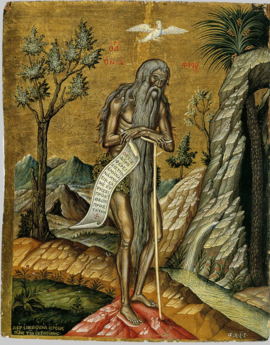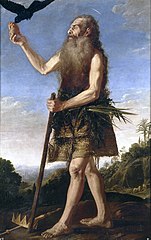
Onuphrius lived as a hermit in the desert of Upper Egypt in the 4th or 5th centuries. He is venerated as Saint Onuphrius in both the Roman Catholic and Eastern Catholic churches, as Venerable Onuphrius in Eastern Orthodoxy, and as Saint Nofer the Anchorite in Oriental Orthodoxy.
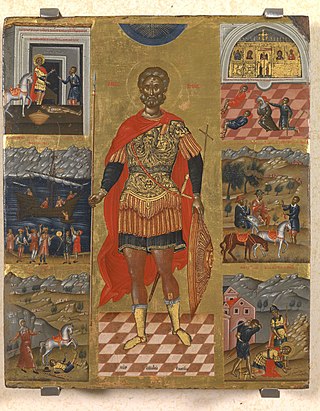
Cretan school describes an important school of icon painting, under the umbrella of post-Byzantine art, which flourished while Crete was under Venetian rule during the late Middle Ages, reaching its climax after the fall of Constantinople, becoming the central force in Greek painting during the 15th, 16th and 17th centuries. The Cretan artists developed a particular style of painting under the influence of both Eastern and Western artistic traditions and movements; the most famous product of the school, El Greco, was the most successful of the many artists who tried to build a career in Western Europe, and also the one who left the Byzantine style farthest behind him in his later career.

The Heptanese school of painting succeeded the Cretan school as the leading school of Greek post-Byzantine painting after Crete fell to the Ottomans in 1669. Like the Cretan school, it combined Byzantine traditions with an increasing Western European artistic influence and also saw the first significant depiction of secular subjects. The school was based in the Ionian Islands, which were not part of Ottoman Greece, from the middle of the 17th century until the middle of the 19th century. The center of Greek art migrated urgently to the Ionian Islands but countless Greek artists were influenced by the school including the ones living throughout the Greek communities in the Ottoman Empire and elsewhere in the world.

Emmanuel Tzanes, also known as BounialisEmmanuel Tzane-Bounialis, Emmanuel Zane, and Emmanuel Tzane, was a Greek Renaissance painter, author, clergyman, and educator. He spent the latter half of his life in Venice, where he was parish priest of the church of San Giorgio dei Greci and a member of the Flanginian School run by the city's Greek Confraternity. Tzanes painted in the style of the Cretan School, influenced by contemporary trends in Venetian painting. His known extant works, over 130 in number, can be found in public foundations, private collections, churches and monasteries in Greece. The most popular of these is The Holy Towel, finished in 1659. Tzanes was a collaborator with Philotheos Skoufos, and brothers with the painter Konstantinos Tzanes and the poet Marinos Tzanes.

Theodore Poulakis was a Greek Renaissance painter and teacher. He is considered the father of the Heptanese School and one of the most prolific painters of Venetian Crete. Poulakis was a member of the Cretan School, his contemporary was Emmanuel Tzanes. Emmanuel Tzanes and Poulakis were active painters of the Cretan School until Candia, went to war with the Ottomans around 1649. Candia finally fell after twenty years of siege in 1669. Poulakis settled on the island of Corfu. Stephanos Tzangarolas was another famous painter in Corfu around the same period. Poulakis's works are likened to Andreas Pavias and Georgios Klontzas. Poulakis works exhibit qualities of the Venetian school. Over 130 of his paintings have survived and can be found all over the world.

Stephanos Tzangarolas also known as Stephano Tzangarola. He was a Greek painter during the late Cretan Renaissance. He migrated from Crete to the island of Corfu. He is a member of the Heptanese School and the Cretan Renaissance. His contemporaries at the time were Panagiotis Doxaras, Theodore Poulakis and Elias Moskos. His artwork began to reflect the transition of the classical maniera greca of Crete to the more refined style of the Ionian Islands. His style resembles the transition of Gentile da Fabriano and Fra Angelico from the maniera greca to their respective styles. Tzangarolas paintings influenced countless artists both Italian and Greek. Some artists that reflect his style include Spyridon Sperantzas and Georgios Kastrofylakas. His paintings can be found all over Greece mainly Athens and the Ionian Islands. Some of his work is in Cairo and London. His student was famous Greek painter Andreas Karantinos.
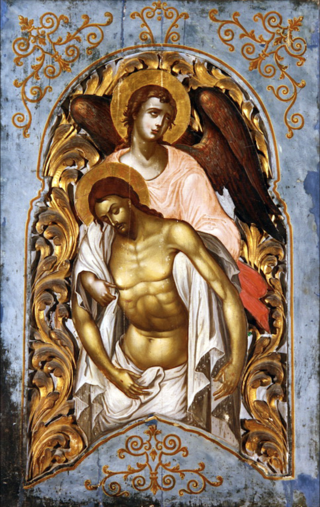
Nikolaos Kallergis, also known as Kalergis. He was a Greek painter during the Greek Rococo and the Modern Greek Enlightenment in art also known as Neo-Hellenikos Diafotismos. His art also exhibited Venetian influence. Painters of the maniera greca began to refine their art. Philotheos Skoufos, Elias Moskos, and Theodore Poulakis were all active painters on the Ionian Islands prior to Kallergis. They set the stage for the transition to the Heptanese School. Panagiotis Doxaras is the forefather of the new painting style. He was the father of Greek Rococo and the Modern Greek Enlightenment in painting. Kallergis became an active member of the school. Kallergis also represents the Greek Rococo. His art began to exhibit qualities of Greek and Italian Neoclassicism. His style influenced countless painters. Examples include Nikolaos Kantounis, Nikolaos Koutouzis, Nikolaos Doxaras, Spiridione Roma, and Eustathios Karousos. His most famous work is Christ and Angel it is at the Zakynthos Museum.

Konstantinos Kontarinis, also known as Konstantino Kontarini, was a Greek Baroque painter of the Heptanese School. He was heavily influenced by the works of Theodore Poulakis. His contemporaries at the time were Stephano Tzangarola and Panagiotis Doxaras. His work signals a transition for the Cretan School to the more refined Heptanese School. Kontarinis clearly follows the traditional maniera greca. The art was heavily influenced by the Venetian style. He influenced the works of countless Greek and Italian painters namely Spyridon Sperantzas and Nikolaos Kallergis. According to the Institute of Neohellenic Research, eighty-five of his works survived. His most notable work is the portable icon consisting of Scenes from Genesis. It is featured at the Byzantine Museum Athens, Greece.

Georgios Kortezas, also known as Tzortzis Kourtezas. He was a Greek baroque painter. He was a member of the Cretan School. He was from a wealthy family. Notable Greek painters active during the same period were Georgilas Maroulis, Ieremias Palladas and Theocharis Silvestros. His style was the Venetian influenced Greek mannerism with some Byzantine influence characteristic of Cretan art. Three of his works survived. The Tragedy of Saint Demetrios. The painting is at the Benaki Museum. The Archangels Gabriel, Micheal, and Raphael. Poli Museum, Corfu. Finally, George Slaying the Dragon is part of the Provatorov Collection in Geneva.
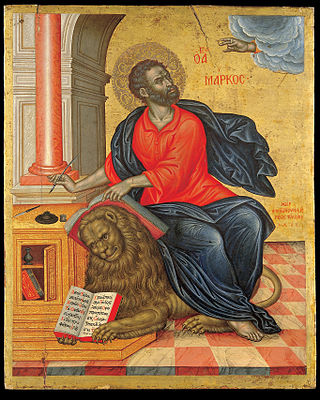
Saint Mark is a tempera-on-wood painting created c. 1657 by Emmanuel Tzanes. Tzanes was a Cretan painter who migrated to Corfu and Venice. He settled in Venice with his brothers Konstantinos Tzanes and poet Marinos Tzanes. Konstantinos was a famous painter. Their combined existing works number over 150. Emmanuel replaced Greek painter Philotheos Skoufos as the priest of San Giorgio dei Greci.
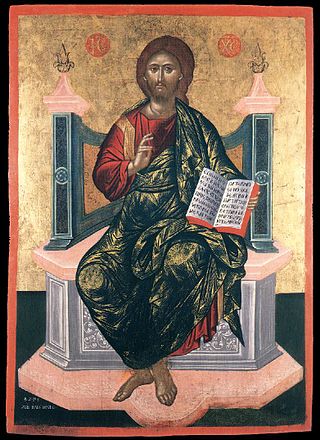
Christ Enthroned is a tempera painting by Elias Moskos, a representative of the Late Cretan School. The artist was also associated with the Heptanese School due to his migration to Zakinthos and the transition of his painting style. Moskos also taught painting. Most of his students became church committee members. Church committees were responsible for commissioning paintings. He was active from 1645 to 1687 on the islands of Crete, Zakynthos, and Kefalonia. Fifty-two of his works survived, over half of them were signed. Two other painters named Moskos were active during the same period Ioannis Moskos and Leos Moskos.

Christ Enthroned is a tempera icon by Emmanuel Tzanes, a Greek painter of the late Cretan school. It is currently at the Byzantine & Christian Museum in Athens.

The Virgin Glykofilousa with the Akathist Hymn is a tempera painting created by Greek painter Stephano Tzangarola. The work is a symbol of the craftsmanship of the Heptanese achool and the evolution of Greek painting from the Byzantine style to the Cretan Renaissance style. Tzangarola was originally from Crete and migrated to Corfu. The Ionian Islands became the artistic center of the Greek world. He was active from 1675 to 1710 during the Greek Baroque period and Rococo. Twenty-two of his works survived. His student was famous Greek painter and Archpriest Andreas Karantinos.
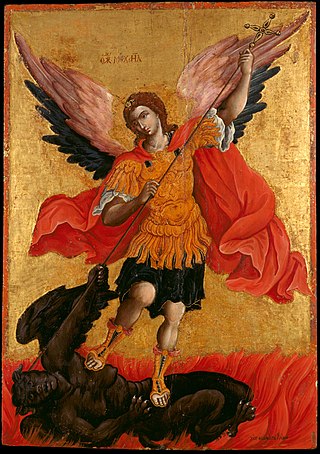
The Archangel Michael was created by Greek painter Theodore Poulakis. He was also a teacher. He was affiliated with Greek painter Philotheos Skoufos. Poulakis was active on the Ionian Islands and Venice. He studied painting in Venice for over a decade. He was also involved with Venetian politics. He was a member of the quarantia. He was a representative of two schools, the Cretan School and Heptanese School. He is considered one of the founding members of the Heptanese School along with Elias Moskos. One hundred thirty of his paintings survived.
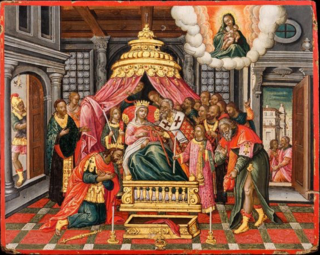
The Miracle of the Holy Belt was completed by Theodore Poulakis. He was a Greek painter originally from the village of Chania, Crete. He was associated with the Cretan School. He eventually migrated to the Ionian Islands. He was a member of the Heptanese School. He settled on the island of Corfu. He was a famous teacher. He signed a six-year contract to teach painting to Marinos Damistras son Tzorzi. The contract stipulated that his student had to follow him to Venice. Poulakis frequently traveled all over the Venetian Empire. During one period of his life, he stayed in Venice for over 13 years. He was very active within the painting community. He was also involved with the prestigious quarantia council. One hundred thirty of his work survived. The Girdle of Thomas also referred to as the miracle of the holy belt is a sacred relic located at Prato Cathedral in Tuscany, Italy.

Constantine and Helen is a painting by Ioannis Moskos. He was a prolific Greek painter associated with Venice and the Ionian Islands. He flourished during the Late Cretan School and early Heptanese School. Three painters with the same last name were active during the same period, the other two were Leos Moskos and Elias Moskos. Ioanni's painting style demonstrates the transition from the Late Cretan School to the early Heptanese School. He began to integrate components prevalent in the Rococo. He was a Baroque artist. According to the Neo-Hellenic Institute, forty-four of his paintings survived.

The Holy Towel is a tempera painting completed in 1659 by Emmanuel Tzanes. He was a representative of the Late Cretan School and the Heptanese school. His brothers were the painter and poet Marinos Tzanes and the painter Konstantinos Tzanes. One hundred thirty works of art are attributed to Emmanuel. He is one of the most important Greek painters of the 17th century along with Theodoros Poulakis. He was from Rethymno Crete. He was active from 1625 to 1690. He was the priest of San Giorgio dei Greci in Venice for thirty years.
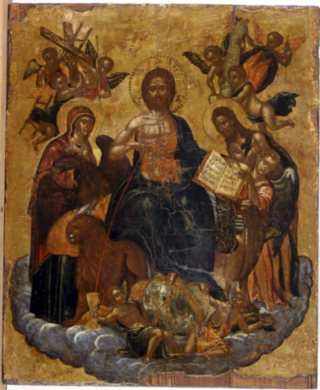
Tribute to the Eucharist was a painting made of egg tempera and gold leaf on a wood panel. The portable icon is attributed to Greek painter Michael Damaskinos. Damaskino's existing catalog features over 100 known works. He was a member of the Cretan school of painting. He was from the island of Crete. His contemporaries were Georgios Klontzas and El Greco. Damaskinos traveled all over Italy for over twenty years. He spent a significant amount of time in Venice. He adopted Italian mannerisms. He applied these new attributes to his paintings. He was friends with sculptor Alessandro Vittoria. He had a collection of drawings obtained from other Italian artists. Namely the Mannerist Parmigianino. He was also exposed to the magnificent works of Italian painter Raphael.

The Incredulity of Saint Thomas is a tempera painting created by Greek painter Emmanuel Tzanes. Tzanes features a catalog of artwork numbering over one hundred works. He was one of the most prolific artists of the 1600s painting in Crete, Corfu, and Venice. His two brothers Marinos Tzanes and Konstantinos Tzanes were also famous painters but Marinos is more well known for his famous poem The Cretan War Ο Κρητικός Πόλεμος. All three artists were members of the Late Cretan School and early Heptanese School (painting) they were known for participating in the movement that integrated Flemish engravings into the Greek and Italian art world.

The Virgin and Child Enthroned is a tempera painting created by Spyridon Romas. He was a Greek painter from the island of Corfu and a prominent member of the Heptanese School active from 1745 to 1786 in Corfu, Lecce, Livorno, and London. Twenty-five of his works survived according to research completed by the Hellenic Institute. One of few Greek painters that changed his style completely Romas transitioned from the Heptanese School to the British style of painting. He traveled to London, England around 1770, and remained in the country until his death. Romas painted several portraits but also maintained art. An important iconostasis containing most of his works is preserved in Livorno, Italy at the Museo della Città di Livorno.
